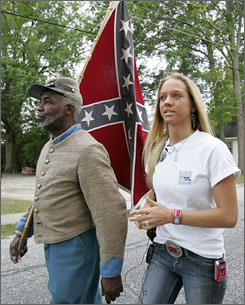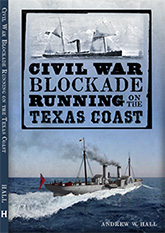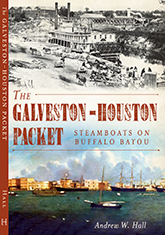Grant Comes to Galveston

![]()
In the spring of 1880, former President and Union General Ulysses S. Grant made a visit to Texas. Fanned by unprecedented press speculation and coverage, huge crowds and celebrities turned out to greet Grant everywhere he went. This was particularly true of the general’s visit to Galveston, at that time the largest and most prosperous city in Texas. Where did Grant go and what did he do? What did he say? And most importantly, what did he eat? Respected historian Ed Cotham answers these questions and more as he chronicles the extensive newspaper coverage of Grant’s historic visit to the island city in his newest presentation for the Menard Summer Lecture Series.

Sunday, June 9 at 2 p.m.
Menard Campus, 3302 Avenue O
Galveston, Texas
![]()
Admission is $10 for Galveston Historical Foundation members, $12 for non-members.
_____________
Image: Morgan Line steamship Harlan, that carried the Grants from Clinton, Texas to Galveston and on to New Orleans in 1880. Museum of Fines Arts Houston/Bayou Bend Collection.
If You See Something, Say Something

![]()
On the other hand, misunderstandings of this sort have happened before. (H/t Kevin)
__________

Throwing Good Money After Bad
 A few weeks ago, the Fourth U.S. Circuit Court of Appeals in Richmond declined to reinstate the lawsuit of Candice Hardwick, the former Latta, South Carolina high school student who spent years, starting in middle school, trying to get herself suspended for wearing Confederate flag t-shirts with captions like “Daddy’s Little Redneck” and “Southern Chick.” Another shirt in her wardrobe apparently featured that fraudulent “Louisiana Native Guards” image. There’s a good story providing the background of this seven-year-old case here.
A few weeks ago, the Fourth U.S. Circuit Court of Appeals in Richmond declined to reinstate the lawsuit of Candice Hardwick, the former Latta, South Carolina high school student who spent years, starting in middle school, trying to get herself suspended for wearing Confederate flag t-shirts with captions like “Daddy’s Little Redneck” and “Southern Chick.” Another shirt in her wardrobe apparently featured that fraudulent “Louisiana Native Guards” image. There’s a good story providing the background of this seven-year-old case here.
As a practical matter, the Fourth Circuit’s ruling probably should have been the end of this case, but now the odious Kirk Lyons is soliciting $5,000 in donations to “help Candice get to the Supreme Court.” Lyons is certainly welcome to ask for money, and folks are welcome to contribute if they desire, but I do think Lyons should have been a bit more forthcoming in explaining the history of the case, and the likelihood of it getting a hearing before the Supremes.
In the first place, getting “cert,” as the saying goes, is a real longshot in almost any case. In any given term, the court is asked to hear thousands upon thousands of cases, but actually accepts only a few dozen — usually less than 1% of the total. There are exceptions, of course, when there are very fundamental and profound legislative questions at hand — the Affordable Healthcare Act and the Defense of Marriage Act are two of recent memory — but generally, the Supremes don’t take cases unless there are conflicting rulings at the lower court level, or the justices — specifically, any four of the nine — deem that the issues raised by the case are worth revisiting. I don’t think that latter circumstance is likely, particularly given that they will likely see this case as not about the Confederate flag per se, but about the broader authority of schools to regulate students’ speech or expression. The most important recent ruling on that subject, Morse v. Frederick (2007), is actually more recent than Hardwick’s original lawsuit, and at 6-3, wasn’t even a close decision. The six justices who voted against the student in that case (Roberts, Alito, Scalia, Kennedy, Breyer and Thomas) all remain on the bench.
Precedent aside, there’s also little other reason to expect Hardwick’s case to get a hearing at the Supreme Court. Best as I can tell, Hardwick’s has only been tried on its merits once, and she lost; everything else in the last seven years has been a round-robin of dismissals and appeals of said dismissals at the appellate level. There’s no particular reason to believe that four justices of the U.S. Supreme Court will see value in committing its resources to hearing a case that lower federal courts have deemed unworthy of their time.
Lyons really ought to be more forthright with prospective donors about the prospects in this case. The fiery rhetoric of his solicitation is calculated to inspire his supporters to open their wallets — “rotten & dishonest school tyranny,” “chicanery, hypocrisy and intellectual dishonesty of the 4th Circuit US Court of Appeals,” and so on — but it’s crafted to appeal to raw emotion, rather than than to cold reason. As is so often the case with “heritage” lawsuits, it’s woefully short on specific details that reflect the actual prospects of the case, or the legal framework within which arguments will be made. The odds against Hardwick’s case even being heard are extremely long, but Lyons’ appeal for cash makes it sound like it’s just a matter of raising the scratch. It’s not.
As I say, people are welcome to contribute if they want, but they should do so only with a clear vision of the return they’re likely to get on their investment.
_________






4 comments